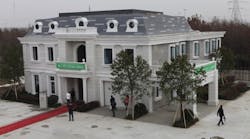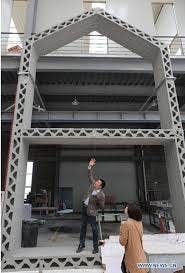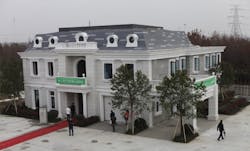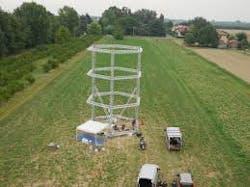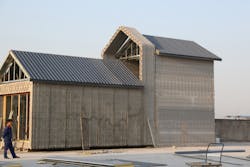The idea of a 3D-printed house began with a simple concept, using a programmable Cartesian coordinate system to extrude cement into layers creating a small, single-story living space. In another approach, some designers made 3D-printed parts that could then be assembled into a building. This technique can be done on-site and can offer supply-chain benefits, as well as solve some problems when printing cement, such as trying to print a second floor, overhangs, or balconies.
âWinSun is one of the companies producing the modular cement designs and in the last year used 3D-printing techniques to print a five-story building, mansions, and other houses in China. While some companies are working on designs to print on-site, others will print parts and then transport them. Transporting prints can have some of the same problems a traditional supply chain must deal with, including the possibility of parts and trusses breaking. However, WinSun says by using this technique it improved process efficiency by 10 times, shortened production time up to 70%, and decreased labor cost by up to 80%.
An Italian company named World’s Advanced Saving Project (WASP) is working on a more mobile design. Allowing on-site printing could generate an entire building rather than the modular design. This approach limits the building’s size, but other techniques could increase the build space. Engineers have presented ideas of tracks or wheels to move the whole printer to construct larger buildings. Another option not used yet (if you have, please contact me at [email protected]) is a cement 3D printer on a multi-axis arm with a gantry system. This is probably due to the weight of the cement and cost, but could offer new techniques in 3D-printed houses that would offer more degrees of freedom.
While many people say 3D printing houses is a gimmick and will never catch on, it could work well in developing nations and could be a solution for areas that undergo rapid expansion where traditional construction can’t keep up. 3D-printed houses are showing the same benefits and limitations as in other 3D printing processes. Engineers need to grow the technology and find out where it fits if it’s going to have any longevity in the construction industry.
3D printing houses, like 3D printing other parts, will not completely replace traditional processes, but it adds another tool to help engineers continue to develop new and interesting solutions. To further this technology, designers should remember to take advantage of inherent properties to increase the benefits of this construction technique. Solar thermal applications would work well with this technique. Offering conventional loop housing and the insulation value of the materials can greatly increase the HVAC efficiency. For example, strategically placed windows with a cement floor would offer amazing opportunity for passive solar. The truss design can provide voids in the walls for networking and insulation, or maybe act as rainwater storage. Continuing the idea of sustainable buildings, these printers are already taking advantage of post-consumer building materials in the cement. Ultimately, 3D-printed houses may not make it over the chasm. There may never be a college course on 3D printing a building in architecture school, but with the right designers and engineers this process might find a home in the construction industry in the future.
3D-printed houses or other products are similar in the following ways: |
|
